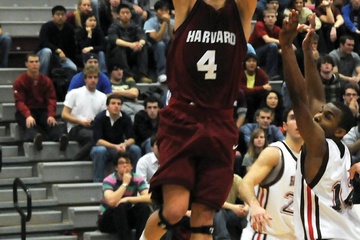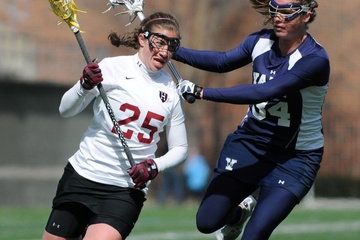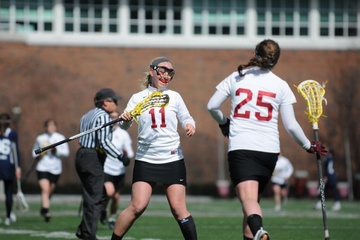The night before Jean Berko Gleason’s final exam in a competitive class, she could not sleep. The phone in her dorm room was ringing every 10 minutes, into the early morning. But whenever she picked up the phone, the caller—one of the male students in her class, she was convinced—hung up.
“I hope they’ve fixed Cabot since I was there,” says Gleason, Radcliffe ’53. “It was just horrible.” Although Gleason was not a fan of the tiny bathrooms and bunk beds, her sentiment reflects a distaste for the restricted social space Radcliffe women were allowed during her years as a student on Harvard’s campus.
In the early ’50s, women at Radcliffe were expected to abide by codes that extended beyond a strict curfew: They could not wear pants into Harvard Square or below the second floor of their buildings past 5 p.m., try out for bands or be elected as official editors of The Harvard Crimson, or even study in Lamont Library. “Harvard thought that if we were there, the men would become so excited that they wouldn’t get any work done,” Gleason says with a laugh. But Radcliffe’s women were determined: Every year, she remembers, a group of Radcliffe students would dress up as men and sit in Lamont until they were thrown out.
“It was true that we were second-class citizens in a lot of ways,” says Lilla Waltch ’53, one of Gleason’s classmates. Life at Radcliffe wasn’t miserable, of course; restrictions from Lamont meant that students planned study dates at Widener and then went out for beer together after. (Still, Harvard men often disregarded Harvard women: “They always said they didn’t want to take out Radcliffe girls and that they’d rather go to Wellesley,” Waltch says.)
Radcliffe women acknowledged that they were receiving an education for which they could be grateful, but it was one that perpetuated stereotypes about women’s roles in the workplace, such as encouraging women to enroll in courses at the Radcliffe Secretarial School. Waltch recalls that Radcliffe students took turns wearing hairnets and serving their classmates in the dining hall, “being on bell” to take phone calls as they came in and sending them to the appropriate floor, and remained under close watch of a house-mother, a practice not mirrored in the men’s river dorms. Gleason remembers that the social relations class she took her freshman year was the same exact course taught on Harvard’s campus at 10 a.m., but the professor trekked to Longfellow Hall to teach it at 11 a.m., separately, for women.
Once most classes became coeducational in 1950, Waltch and Gleason’s sophomore year, their male classmates snickered: They insisted that when professors said, “Good morning” to the class, the men returned the greeting, while the women wrote it down in their notes.
Gleason stresses that Radcliffe and Harvard were never distinct schools; rather, Radcliffe was just a means by which women could attend Harvard. “By having the fiction of Radcliffe,” Gleason says, “Harvard was allowed to discriminate against women, long after it should have stopped—just because they were let in through another door. Harvard may have been at the forefront of scholarly things, but it was not at the forefront of civil rights.”
The restrictions imposed on women’s access to Harvard were not applicable in the opposite direction: “Men could come and go as they pleased,” Gleason says—they had open access to Radcliffe’s library, for instance. “They were free people, and we were not.”Real structural change would come later, but attitudes among those attending Radcliffe were already shifting. “Don’t think we didn’t notice. The women’s movement came at a time when many people had been brewing over these things for a long time.”
*******
It was, Carol R. Sternhell ’71 insists, as if she had stepped from the ’50s into the ’70s from one day to the next. When Sternhell was a freshman living in Barnard Hall in the Radcliffe Quad, students still lived under the restrictions of curfews, sign-ins, and house mothers. But two years later, the University undertook an experiment: 150 Radcliffe women moved into rooms in Lowell, Adams, and Winthrop, and 150 Harvard men moved up Garden Street into the Quad, in an attempt at integration beyond the classroom. (The University only afterward added a bus serving the Radcliffe Quad.)
“All the rules were gone in every aspect of life,” Sternhell says. Sternhell, who had moved to Adams House and later became the second female managing editor of The Crimson, already considered herself an activist, though she wasn’t focused particularly on gender: “We were fighting for so many things at once, and this was part of it: freedom, freedom, freedom.“
Even with the increased liberties for women on campus, Esther Dyson ’71-’72 noticed certain reinforcements within the deterioration of these norms. “It was the ’60s,” Dyson, another Crimson editor, explains. “It was certainly a world where we were supposed to be decorative, and the boys were supposed be smart.” Dyson does not remember being too confined by this conception, though. She does remember attending student-worker alliance meetings, swimming naked in Adams pool every morning, and “kidnapping” Hasty Pudding Theatricals Man of the Year Dustin Hoffman from a party.
Radcliffe women were negotiating space for themselves beyond the river houses—a role in which women could speak and impact change outside of the classroom. One of Sternhell’s most vivid memories is reporting on the student takeover of University Hall in 1969. “Do I remember any classes?” she jokes. “Not really. Do I remember any protests? Many.” Dyson, too, says she “rarely went to class.”
It was a dramatic environment, Sternhell says, one in which she and her classmates "felt we had to save the world." There was already a revolution of sorts that had seeped into campus and spread. But it was a movement that Sternhell believes wasn’t analyzed or recognized at the time: the growing conceptualization and consciousness of modern feminism. “We stopped calling ourselves girls and started calling ourselves women, overnight,” she explains. “It was revolutionary to say women should have equal rights—it was unbelievable.”
By senior year, Dyson says she had grown up, and Sternhell says she was indignant. They were Radcliffe students who went to school at Harvard; they weren’t going to spend their lives answering phones. Sternhell and her classmates would wear raised fist silk-screenings on the back of their graduation gowns to advocate for equal admission of women to the University. They were revolutionaries: They were feminists.
This article has been revised to reflect the following clarification:
CLARIFICATION: February 24, 2013
An earlier version of this article stated that Radcliffe women could not try out for organizations like The Harvard Crimson in the early 1950s. To clarify, while the first woman was not elected as an official editor of The Crimson until 1959, female students could contribute to The Crimson as Radcliffe correspondents beginning in 1947.






